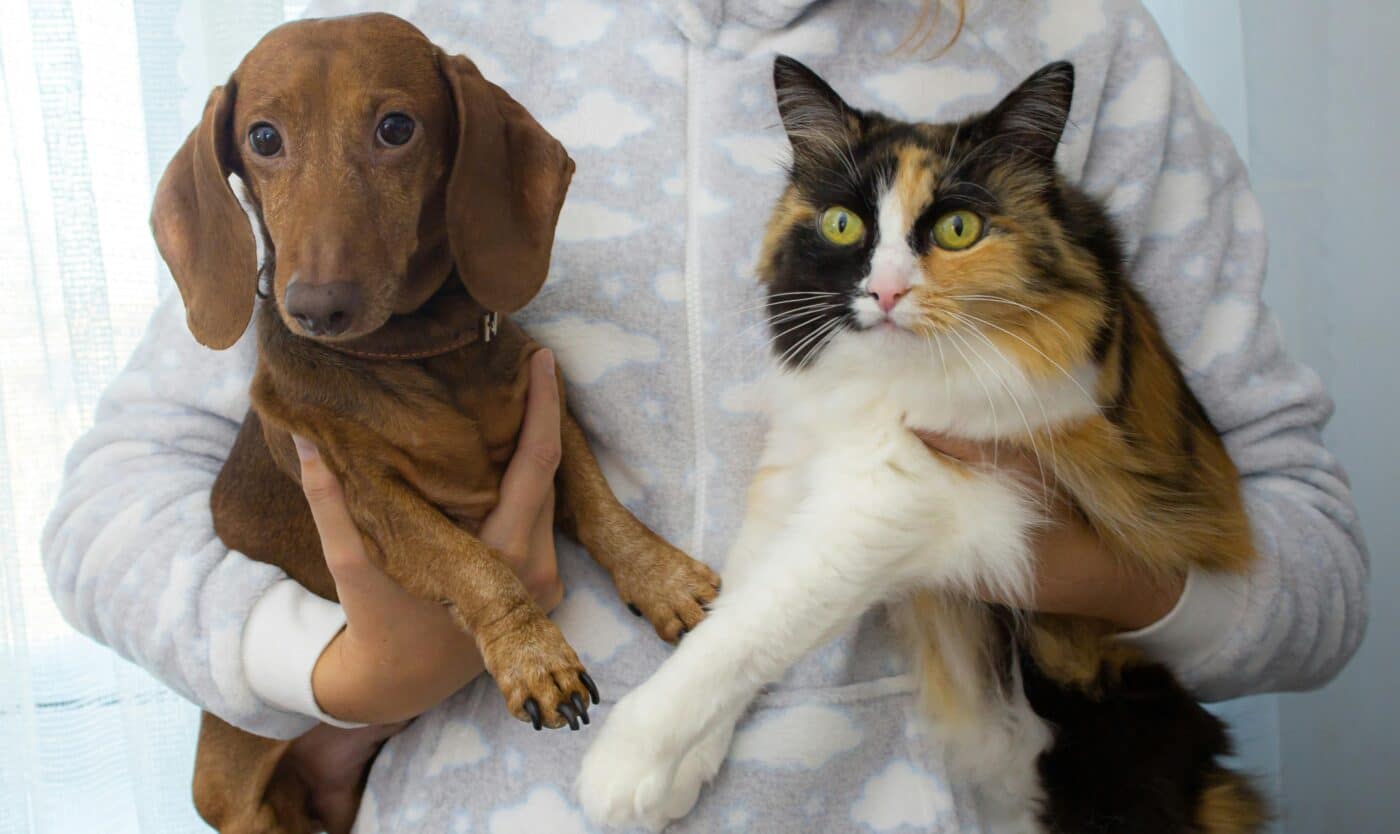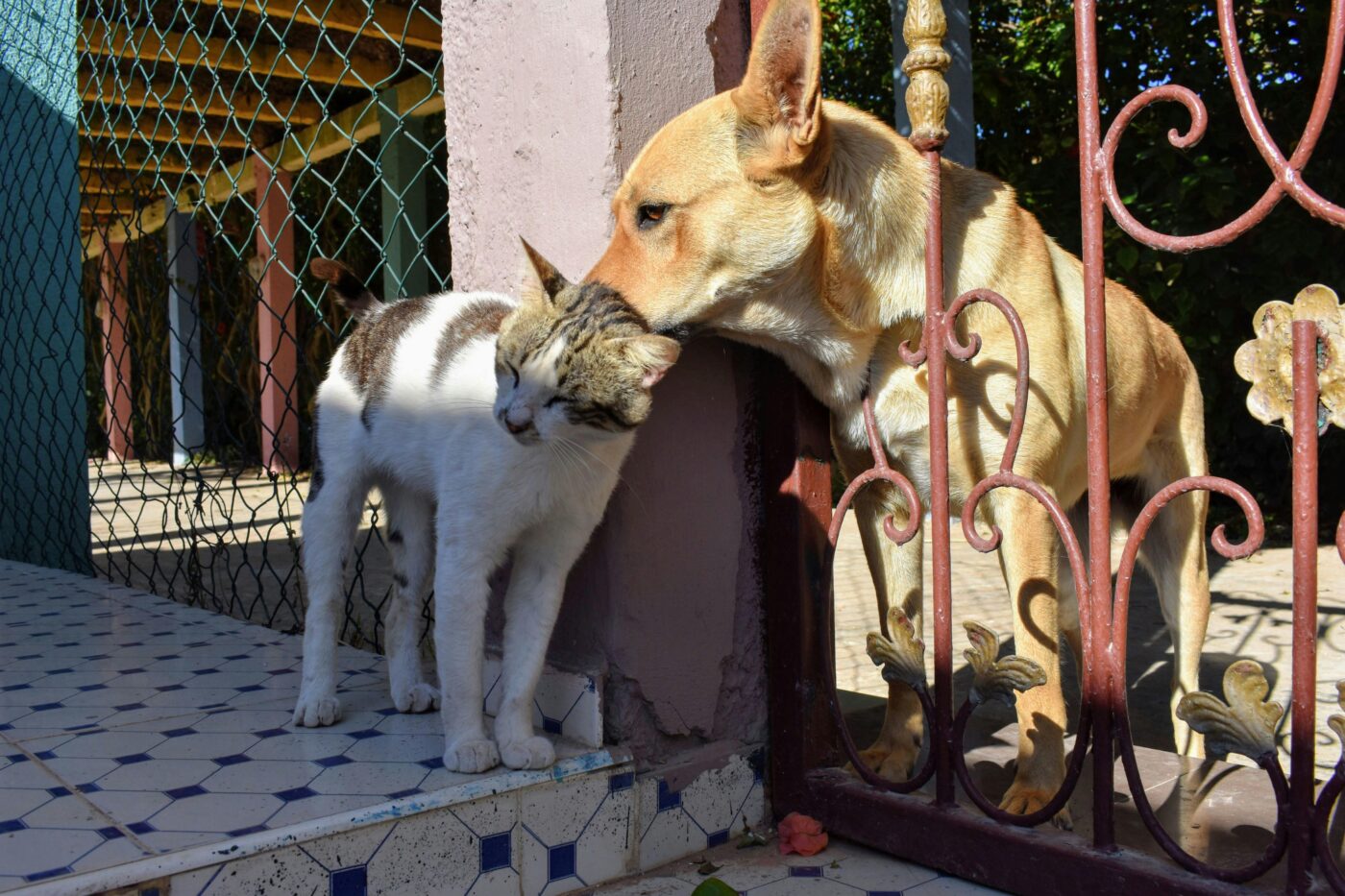

While dogs and cats are often seen as natural rivals, they can actually develop impressive ways of communicating with each other. Through unique body language, vocal cues, and subtle gestures, these animals create a mutual understanding. Dogs are often direct and social in communication, while cats prefer cautious, subtle signals. When sharing a space, they learn to interpret each other’s “signals,” forming an unspoken language. This fascinating form of interspecies communication shows how, despite their differences, dogs and cats can achieve harmony by attuning to each other’s cues.
Tail Talks

One of the most noticeable ways dogs and cats communicate is through their tails. While a dog’s wagging tail often signals friendliness or excitement, a cat’s tail may tell a different story. In cats, a flicking tail usually means agitation or alertness, while a high, straight tail signals contentment. Over time, dogs learn that a cat’s tail wag isn’t an invitation to play but rather a sign to approach with caution. Similarly, cats observe that a dog’s wagging tail often means excitement or curiosity, not a threat. These tail signals serve as mutual cues that help dogs and cats interpret each other’s moods, guiding their actions and reactions.
Eye Contact

Though their interpretations differ, both dogs and cats use eye contact to communicate. For dogs, direct eye contact with soft eyes often means trust or affection, while a hard stare might indicate a warning. Cats, however, are more nuanced. They use “slow blinks” to show trust and affection, a behavior often reciprocated among humans, too. Dogs that have lived with cats for a while learn to recognize the slow blink as a signal of calmness rather than an invitation to chase. Similarly, cats realize that a dog’s softened gaze and lack of direct eye contact mean they’re friendly or indifferent. This mutual respect of “eye language” helps them develop a peaceful coexistence.
Paw Gestures

Paw gestures are another key part of dog and cat communication, often signaling play or establishing boundaries. For example, a playful swat from a cat might seem aggressive to an unfamiliar dog. Still, dogs used to engage in feline communication recognize it as a friendly invitation to interact—although with some space. In return, dogs might respond with a gentle paw pat, which cats quickly understand as a non-threatening response. Although different, this exchange of paw gestures gradually becomes a shared language where both parties understand each other’s comfort zones and play styles.
Vocal Cues

Dogs and cats both vocalize, but their “vocabulary” is very different. Dogs communicate with various barks, whines, and growls, while cats typically use meows, purrs, and hisses. Through exposure and patience, dogs and cats that live together learn to interpret each other’s vocalizations. For instance, a dog might understand that a cat’s hiss is a warning, not an invitation for closer contact. Cats, on the other hand, learn that certain dog barks mean excitement, while a low growl signals a need for distance. This vocal adaptation allows both animals to respect each other’s boundaries, minimizing conflicts.
Body Positioning

Body posture plays a huge role in interspecies communication. When a dog bows, it’s typically a “play bow,” an invitation for fun. Initially, a cat might misinterpret this gesture as a pounce, especially if they are unfamiliar with dogs. However, over time, many cats learn that the dog’s bow is a harmless invitation to play. Similarly, dogs recognize that a cat arching its back is not playful but defensive. By learning to interpret each other’s body positions, dogs and cats can gauge the other’s emotional state, deciding whether it’s safe to engage or better to keep their distance.
Scent Marking

Scent marking is a primary way cats communicate, leaving subtle olfactory signals for other animals. They mark their territory by rubbing their faces on objects, which may confuse dogs initially. Dogs, who are also driven by scent, learn that these scent marks are “off-limits” areas that should be respected. Additionally, cats may rub against dogs to “claim” them, which many dogs come to accept as a neutral or even friendly gesture. This scent-sharing technique helps establish boundaries within shared spaces, creating a silent but effective communication method that respects each other’s need for personal space.
Space Respect

Dogs are often eager to explore and may invade a cat’s personal space unintentionally. Cats, however, prefer defined boundaries and controlled interactions. In multi-pet households, cats often establish certain spaces as their territory, like high perches or secluded nooks, where they feel safe. Dogs that live with cats quickly learn these boundaries, understanding that a cat’s designated area is a “no-go” zone. Similarly, cats observe that some areas, like the backyard or the dog’s bed, are dog-dominated. By respecting each other’s territories, dogs and cats create a peaceful environment where each animal feels secure.
Play Styles

Dogs and cats have inherently different play styles. Dogs are often more boisterous and enjoy games involving fetch or tug, whereas cats prefer stealthy, solitary play like stalking and pouncing. When dogs and cats play together, they learn to adapt their play styles to each other’s preferences. A dog might tone down its energy, engaging in a slower, more controlled manner to avoid overwhelming the cat. Cats, on the other hand, may engage in short bursts of play, understanding that dogs are persistent and energetic. This mutual adaptation allows them to enjoy playtime while respecting each other’s comfort zones.
The Nose Boop

Dogs and cats use their noses to explore and connect with the world, and a “nose boop” is a friendly gesture between them. When a cat gently touches its nose to a dog’s, it’s often a way of saying hello. Dogs, who are naturally inclined to sniff as a greeting, respond positively to this gesture. Over time, this small mutual acknowledgment becomes a quiet, respectful greeting between them, often preceding more interactive play or friendly body language.
The “Feline Freeze” and the “Canine Calm”

In moments of tension, both dogs and cats have unique signals to keep the peace. Cats may employ the “feline freeze,” staying very still to avoid triggering a dog’s prey drive. Dogs, in turn, learn to adopt a “canine calm” by sitting or lying down to appear non-threatening. By using these signals, they communicate that they mean no harm, helping to defuse potential conflicts. This mutual respect and awareness highlight interspecies communication’s complex, cooperative nature.
When Cats and Dogs Have Their Own Secret Language

The ways that dogs and cats communicate reveal a sophisticated, often surprising, level of mutual understanding. With such different instincts, these two animals adapt and learn to interpret each other’s subtle signals, creating a language all their own. From nose boops to shared play styles, they demonstrate that true friendship doesn’t require words. Observing these “secret signals” can offer a fascinating glimpse into the unique bond between dogs and cats, a relationship built on respect, adaptation, and the occasional playful chase.
The post How Dogs and Cats Communicate With Each Other in Secret Signals appeared first on iHeartDogs.com.
